An 10 days family adventure trip to China is a very good experience, especially for the kids. You will visit more than the most popular cities in China, such as Beijing, Xi’an and Shanghai. All the classic and must-seen attractions included, like the Forbidden City and Great Wall in Beijing, Terra Cotta Warriors in Xi’an and Yuyuan Garden and Shanghai Tower in Shanghai. Besides the classic routine, this family tour itinerary also adds an Avatar family adventure tour in Zhangjiajie! You will step on the Transparent Glass Road and feel that your heart is beating by your ears. Come join us, and you won’t regret it. We are also flexible with the program, and we could tailor-make your own family tour to China. What are you waiting for? Contact us right away!

Beijing is the city with the most World Heritage Sites (7) in the world and the first capital city in the world to have a World Geopark. There are more than 200 tourist attractions open to the public in Beijing, including the Forbidden City-the world's largest imperial palace, the Temple of Heaven, the royal garden-Summer Palace, as well as famous sites such as Badaling Great Wall, Mutianyu Great Wall. Beijing is a warm temperate semi-humid climate zone with four distinct seasons, short spring and autumn, and long winter and summer. The average annual temperature is 13°C(55.4°F), the coldest is January with an average temperature of -3.7°C (25.3°F), the hottest in July with an average temperature of 25.2°C (77.3°F), and the average annual rainfall is 507.7 mm. The frost-free period is 189 days.
After meeting and greeting you at the airport, the guide will take you to the hotel for a rest.
The rest time would be yours to discover the surroundings.
Today, our Beijing tour will start from Tian’anmen Square. Located in the central axis of Beijing, Tian’anmen Square is an important place for holding major celebrations, grand gatherings and welcoming foreign affairs of the Republic. The Tian’anmen Gate Tower is located at the northern end of the square. Tian’anmen Gate Tower was built in the 15th year of the Ming Dynasty (1417), originally named Chengtianmen, and then called Tian’anmen after the reconstruction in the 8th year of the Qing Dynasty (1651). On October 1, 1949, Chairman Mao Zedong proclaimed the founding of the People's Republic of China on the Tian’anmen Gate Tower and pressed the button to raise the five-star red flag with his own hands. Since then the Tian’anmen Gate Tower has become the symbol of the new China.
Walkthrough Tian’anmen Square, we will reach the former royal residence – the Forbidden City (Closed each Monday). The Forbidden City houses a large number of ancient art treasures, which according to statistics amount to 1052,653 pieces, accounting for one-sixth of the total number of cultural relics in China. In the Forbidden City in each of the front and back of the palace, there are stone steps. In the middle of the steps, it is a long-slanted stone, carved with a dragon, phoenix, seawater river cliffs and other patterns. This thing is called "Lingchi Stone". The largest Lingchi Stone is located in the back of the Hall of Preserving Harmony. It is carved from a stone of more than 300 tons which was discovered on the Fangshan Mountain. Without the cranes at the time, how did this big stone get from the Fangshan mountains to the Forbidden City? It turns out that it took more than 10,000 workers to transport this large stone, and this work deliberately was done in the coldest days in winter. On the way from Fangshan Mountain to Forbidden City, the workers dug a well every 1 mile. They sprinkled water from the well on the ground and let the water freeze. The ice was used to reduce the friction and then the stone was pulled to Forbidden City little by little. The wisdom of the workers in the Qing Dynasty is unbelievable!
Our lunch will be at a local restaurant.
After lunch, we will drive to the Temple of Heaven. The Temple of Heaven is the largest surviving ancient ritual building complex in China and the world, and was built in the 18th year of the Ming Dynasty (1368-1644). The Temple of Heaven is a typical altar where the Ming and Qing emperors offered sacrifices to heaven and prayed for good harvests.
In October 1986, Queen Elizabeth II and her husband, the Duke of Edinburgh, came to visit the Temple of Heaven. She asked the staff that the ancient Chinese emperors went to the Temple of Heaven to pray for good winds and rain, and that Europeans had also prayed for rain, so why did China also pray for the wind? The staff explained that the staple food of Chinese people is grass plants, which depend on wind pollination. If there is no wind when crops are in head sprouting and bloom period, they will not grow to full size, and the yield may be reduced in the future. The Queen thought the culture of the East was remarkable. Just like that, the Queen was enchanted by the Temple of Heaven. The guide will show you all the places the Queen has visited.
Then we will visit our last stop, the Summer Palace.
The Summer Palace, located in the western suburbs of Beijing, is the first of China's classical gardens and was inscribed on the World Heritage List on December 2, 1998.
Renshou Hall is one of the main buildings in the Summer Palace. There is a special well on the north of the Renshou Hall. It was the source of water for Dragon Lady Cixi and Emperor Guangxu. It also has a nice name: Yannian well. Yannian in Chinese means “prolong life”. It is said that in the summer of 1903, the heat was unbearable, so Dragon Lady Cixi went to the Summer Palace to escape the heat. It may be that the weather is too hot and Dragon Lady Cixi got heatstroke on the way to the Summer Palace. After arriving at the Summer Palace, Dragon Lady Cixi fell ill and could not be cured for a long time. One day during a nap, Dragon Lady Cixi had a dream. She dreamed that there was a well next to the Renshou Hall. When she woke up, she sent someone to dig, and a well was dug. The heat suddenly disappeared after Dragon Lady Cixi drank a bowl of water from the well, and her illness was miraculously cured. Dragon Lady Cixi thought that the water of this well can cure disease, so it may also prolong their own life. Then the well was designated as the imperial use, and named it as Yannian well. Thereafter, as long as Dragon Lady Cixi lived in the Summer Palace, it is necessary to drink the water from the well of Yannian, and make tea with well water. The guide will show you the location of the well.
In the end, we will go back to the hotel.
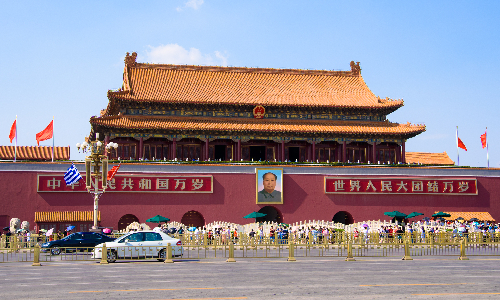
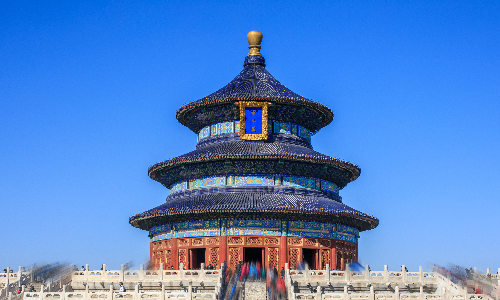
After breakfast, we will drive about 1 hour to visit Ming Tombs.
The Ming Tombs are located in Changping District, 50km northwest of Beijing. It takes around 1 hour from city center. Ming Tombs covers an area of 80 square kilometers. Ming Tombs is the general name for the 13 tombs of the Ming emperors which is one of the best-preserved tomb building groups in the world today. Among the Ming tombs, only Chang Tomb, Ding Tomb, Zhao Tomb and Sacred Road are open at present. Today, we will visit the Ding Tomb. Ding Tomb is the tomb of Emperor Wanli and his two queens (Empress Xiaoduan and Empress Xiaojing). This is the only royal underground tomb excavated by the government, and it took 2 years to find the entrance to the underground palace. The guide will tell you some interesting stories about Emperor Wanli and his two queens.
We will have our lunch at a local restaurant on the way to the Badaling Great Wall. Badaling Great Wall is 40 kilometers to the northwest of the Ding Tomb, and it needs to drive about 40 minutes. Badaling Great Wall is a part of the Great Wall, and was built in 1505, and was repaired during the reign of Emperor Jiajing and Wanli of the Ming Dynasty. It is said that after Badaling was repaired that year, the government arranged soldiers to guard on Badaling throughout the day. The soldiers often needed to guard and stand for a long time, and they sometimes dozed off from exhaustion. But they were very afraid that if they fell asleep the enemy climbed up to Badaling. Therefore, they prayed to God: God, please bless me, don't let me fall asleep. When the enemy comes, please let me know.
Then God heard them, and he thought the soldiers were having a hard time and wanted to help them. So, he sent the god of grass to bring Xima grass seeds and scatter them outside the Badaling Great Wall. The grass grew up and was everywhere. This kind of grass was so poisonous that when people touched it, it hurt people like a scorpion sting, and people screamed in pain. So, in this case, when the enemies tried to climb the Great Wall and touched this grass, they would be stung and scream. And the soldiers would wake up by their screaming sound. This legend is just one of the many legends of the Great Wall. The guide will tell you more interesting stories about the Great Wall.
After admiring the stunning view of the Great Wall, we will drive back to the hotel.
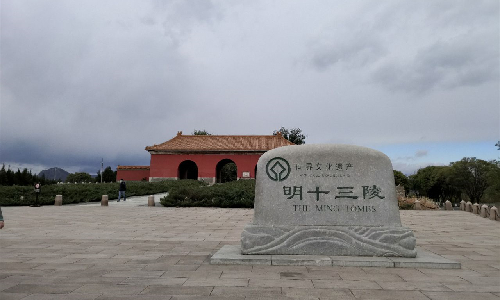
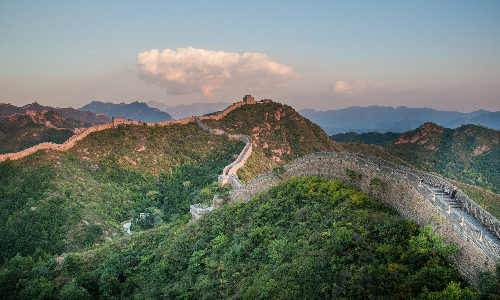
 Xi’an
Xi’an This morning, our guide will take you to the train station. You will experience the high-speed train by taking the estimated train G307 09:38/15:16 to Xi’an. The total train journey will last about 5 hours.
Xi'an, known as Chang'an in ancient times, has a history of more than 3,100 years as a city and 1,100 years as a capital, with 13 dynasties having established their capitals here. Since the Western Han Dynasty (202 BC- 8 AD), Xi'an has been an important city for economic and cultural exchanges, as well as friendly relations between China and other countries around the world. The Silk Road started from Chang'an and went west to ancient Rome. Xi'an is a world-famous historical city, and the Chang'an culture represents the essence of Chinese culture.
When you arrive at Xi’an train station, our local guide will meet and greet you at the entrance. The first stop is the Xi’an City Wall. The City Wall of Xi'an, also known as the Xi'an Ming City Wall, is the most complete ancient city wall in China, the second-longest in the country. If we have enough time, you could take a bicycle on the City Wall, and it’s a unique experience.
After saying goodbye to the City Wall, we will visit the Muslim Quarter. Xi'an Muslim Quarter is made up of several roads which is a must-visit when you first arrive in Xi'an. You can taste nearly 300 kinds of snacks, such as meat sandwiches, Southeast Asian steamer cakes, steamed bun, and cold rice noodles.
Have some free time in the Muslim Quarter, and then we will go back to the hotel.
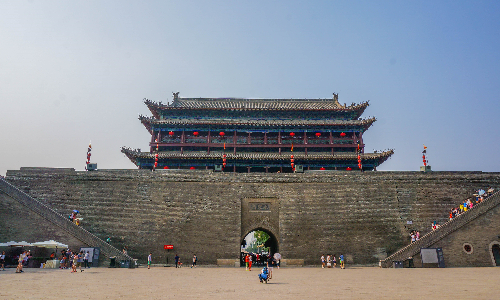

After breakfast, we will drive for about 1 hour to Terra Cotta Warriors and Horses Museum which is located in Lin Tong District. It is 40 kilometers to the northeast to the city center. In 1987, the Terracotta Warriors and Horses Museum was approved by UNESCO to be inscribed on the World Heritage List, and was hailed as the "Eighth Wonder of the World". There are currently three terracotta pits open to visitors, and more than four hundred pits have been discovered by the archaeologists at the tomb of the First Emperor in China’s history, Qin Shi Huang. Among the three pits that have been excavated, only one is intact, while the others are under restoration. As part of the tomb of Qin Shi Huang, the terracotta warriors are only the tip of the iceberg of the entire tomb. After two excavations of the tomb of Qin Shi Huang, no further excavations have been carried out, mainly because of two reasons. The first is a technical problem. The tomb is more than three thousand years ago, and it is easy to cause damage to cultural relics in the process of excavation. The second point is the research problem. The amount of information contained in each artifact excavated from the tomb is enormous, and archaeologists need to conduct a comprehensive and detailed study. The restoration of the relics has not yet been completed and there is no need for new digging. We expect that someday in the future, after technological advances, we will be able to fully uncover the tomb of the First Emperor and learn all its secrets.
Our lunch will be at a local restaurant near the Terra Cotta Warriors and Horses Museum.
On the way back, we will go and visit the Small Wild Goose Pagoda(closed each Tuesday). The Small Wild Goose Pagoda was built in the Tang Dynasty(618-907) and is now located in the Xi'an Museum. The pagoda has survived more than 1,200 years of wind and rain, 70 earthquakes and 3 breakups in its history. Our guide will tell you more about this story.


 Zhangjiajie
Zhangjiajie Today you will take the estimated flight 3U3271 14:35/16:05 to Zhangjiajie.
With no severe cold in winter and no scorching heat in summer, and an average annual temperature of 16.8°C(62.2°F), Zhangjiajie can be said to have four seasons like spring. The best time to travel is April and October every year, in these two months, Zhangjiajie has the most beautiful natural scenery. In July, it always rains in Zhangjiajie, and the roads are slippery after rain, so it is not suitable for hiking. 1 or 2 hours after the rain, the mountain scenery is the most beautiful. The mountains are mist-covered, like a fairyland. In winter, the attractions in mountains will not be closed after it snows, and Zhangjiajie in the snow is another kind of beauty.
Our local guide will pick you up from the airport and take you to the hotel for a rest.
Today, your exciting Zhangjiajie day tour will start from the Zhangjiajie National Forest Park. We will take a cable car up to visit the Huangshi Village. There is a large observation deck at Huangshi Village. This observation deck has a wide view and overlooks the entire forest landscape on top of the mountain, with picturesque mountain view, which makes you feel like you are in the middle of a mountain painting. When you stand on the observation deck, you can feel the whole river and mountain at your feet.
Then we will take a walk to the Golden Whip Stream which is located in the eastern part of Zhangjiajie National Forest Park, named after the Golden Whip Rock. It is 5700 meters long and runs between the walls and peaks, with lush vegetation in the valley and clear water in all seasons, and is known as a "fairyland on earth". On the way, you will see a singing station where there are Tujia girls ready to sing ethnic songs for visitors. If you pay 10 yuan, they will sing for you. Of course, if you don't want to spend extra money, you can also listen to the songs ordered by others and leave afterward.
Lunch will be at a local restaurant in the park.
Then we will take a sightseeing bus to leave the Zhangjiajie National Forest Park and be transferred to Zhangjiajie Grand Canyon. It takes around 30 minutes on the road. The vegetation in the canyon is lush, the air is fresh, and the waterfalls and small streams and springs can be seen everywhere, which make this place a natural oxygen bar. In addition to enjoying the natural scenery, the most worthwhile scenic spot is the glass bridge - Zhangjiajie Grand Canyon Glass Bridge. When you stand on the bridge, the scenery of the valley floor 400 meters below your feet can be seen, which is very challenging to your heart.
After visiting, we will drive about 40 minutes back to your hotel.

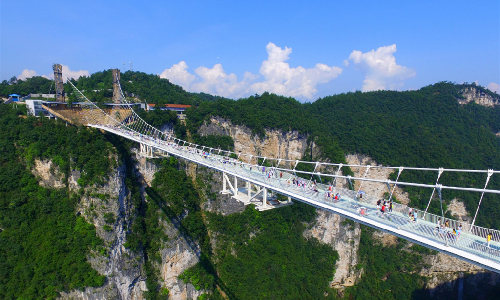
 Shanghai
Shanghai After breakfast, our guide will take you to the airport according to the flight schedule. The estimated flight is MU5196 12:30/14:30 from Zhangjiajie to Shanghai.
As a world metropolis, there is no strict seasonal limit to visit Shanghai. But every spring (March-May), the plum blossoms in Qingpu, rape flowers in Fengxian, peach blossoms in Pudong, and orchids in Songjiang bloom one after another, make it a beautiful place to visit. Autumn (September-November) is the best time to taste crabs. There are many snacks made with crab in Shanghai. For example, crabmeat wontons, crabmeat dumplings and crabmeat shrimp noodles. You should definitely try some during your trip to Shanghai. In July and August, the temperature in Shanghai is high, so it is not suitable for outdoor sports; in January and February, winter is the coldest season in Shanghai, so you should pay attention to the cold and keep warm when you go there; in June and July, it is the rainy season in Shanghai, so you should bring an umbrella when you go out.
Upon your arrival, the driver and guide will hold your name sign and wait for you at the Shanghai airport. They won’t leave until your appearance. Then you will take a private vehicle to the centrally located hotel overnight. The rest day would be your own time to spend.
Our Shanghai tour will start from the Jade Buddha Temple. Jade Buddha Temple has a history of more than 120 years, and is located on Anyuan Road in Putuo District. It is not only a famous temple in Shanghai, but also a Buddhist monastery is known both at home and abroad. It is described as a piece of pure land in the downtown area. According to legend, during the Qing Dynasty, Monk Huigen of Putuo Mountain made a grand vow to visit every Buddhist holy place in the world. He trekked through the mountains and rivers, finally, he arrived in Myanmar. One night, he passed through a valley, and in the darkness, he found a bright light shining not far ahead. Startled, he hurriedly walked over and touched it with his hand, and found it was a large jade stone. He thought, if the stone can be carved into the Buddha statue, that would be great. He told the local people what he thought. The local people and Buddhist believers were eager to contribute money and effort, and soon the jade stone was shipped out of the valley. Monk Huigen also found the best Buddhist carver in Myanmar to carve the jade. After several months of work, the jade was carved into 2 exquisite Buddha statues. Where should these two Buddha statues be sent to? Monk Huigen could not decide for a while. That night, he had a dream in which he was told that the two jade Buddhas should be sent to the East Sea coast. When he woke up, he recalled what he was told in the dream and realized that he should send the two jade Buddhas to China. Then he built a temple in Shanghai on the banks of the Chunshen River. This is the origin of the two jade Buddhas in Jade Buddha Temple.
Afterward, we will drive to the Yu Garden(Closed each Monday). The Yu Garden is a private garden of the Ming Dynasty (1368-1644), known as the "City Mountain Forest", which is a pearl among the gardens of the south of China. Outside the Yu Garden, there are hundreds of stalls selling local hand-crafts, local snacks and souvenirs. You can buy silk products and taste soup dumplings here. Take your time and walk around. Our lunch will be at a local restaurant in this area.
Then we will drive through the tunnel under the Huangpu River to the Shanghai Tower in the Lujiazui Financial Center. Shanghai Tower is the tallest building in Asia. You can only see the top of the building by looking up at the sky with a tired neck. You could have a full view of Shanghai city from the observation deck on the 118th floor if the weather is clear.
Then we will go back to the hotel.
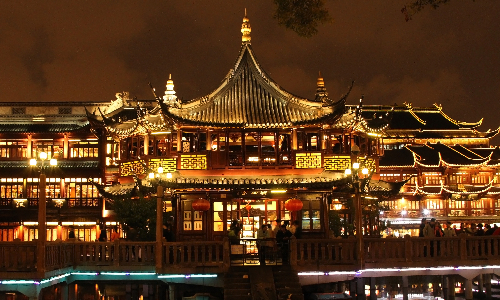
After checking out from the hotel, the guide will take you to the airport. You will fly back to your sweet home.
Editor: Lexie Jia
Proofreader: Summer Hou
| City | Five Star hotel list | Four Star hotel list |
|---|---|---|
| Beijing | Sunworld Dynasty Hotel Beijing Wangfujing | Sunworld Hotel Wangfujing |
| Xi'an | Tianyu Gloria Grand Hotel Xi'an | Sunworld Dynasty Hotel |
| Zhangjiajie | Zhangjiajie Qinghe Jinjiang International Hotel | Zhangjiajie Huatian Hotel |
| Shanghai | Ocean Hotel Shanghai | Courtyard by Marriott Shanghai Central |
 |
![]() About your child or infant, please contact us for a discounted price.
About your child or infant, please contact us for a discounted price.



We started with a few days in Beijing & ended in Shanghai, from where we visited the Forbidden City and Great Wall. In between we visited Terra Cotta Warriors Museum, Panda Base, Shanghai Disneyland.

We had a wonderful holiday in China which will remain long in the memory. China is a breathtakingly beautiful country full of splendid temples and palaces, mountains and rivers, peaceful rural scenes and bustling shopping streets.
 QUICK ENQUIRY
QUICK ENQUIRY